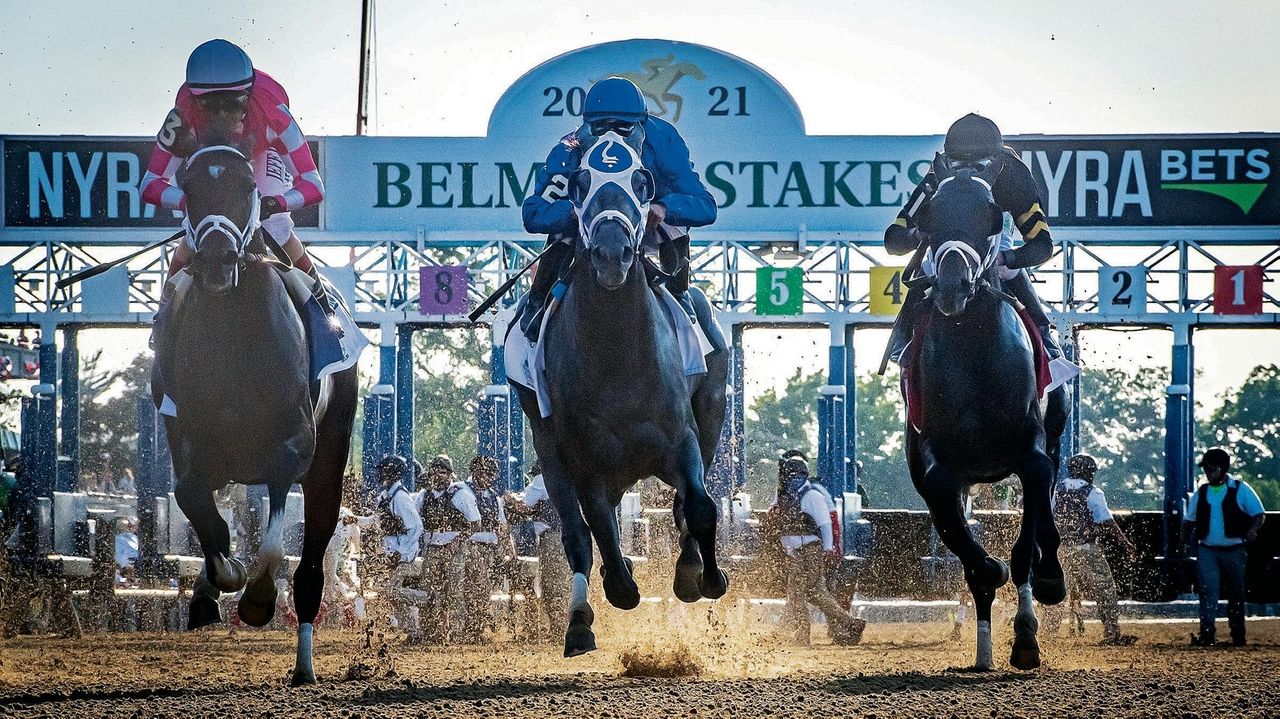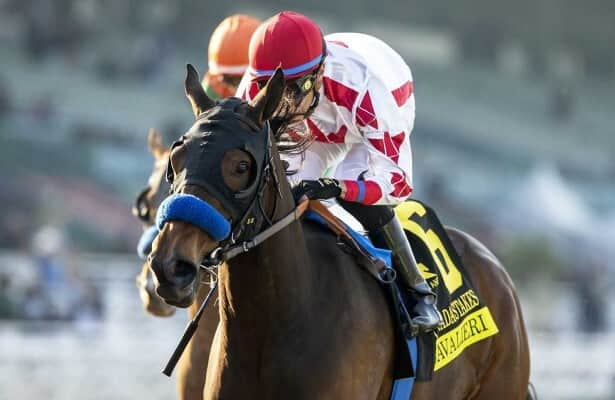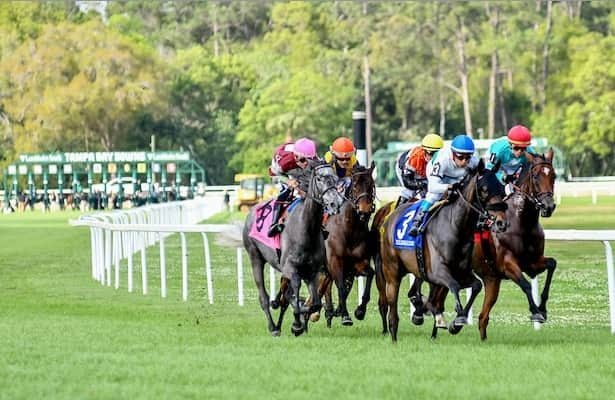Racehorse injuries: Hochul’s budget calls for new tech to help prevent them

ALBANY — Gov. Kathy Hochul’s budget proposal calls for bringing a new, advanced imaging system to Long Island to help develop better ways to detect and prevent serious injuries to racehorses after a 2023 spike in deaths from Belmont Park to Santa Anita Park in California.
The imaging system would be located at the Cornell University Ruffian Equine Specialists veterinary facility adjacent to Belmont Park in Elmont. Cornell researchers would undertake a study of “thoroughbred fetlock joint injury detection through advanced imaging” to develop better ways to care for horses, to identify weaknesses in bone and tissue, how long they need to be rested and treated after injury, and other safety protocols.
“This study will examine whether a more robust screening protocol can be developed to assist in reducing severe injuries before equine athlete races and therefore reduce equine fatalities,” according to documents released as part of Hochul’s budget proposal on Tuesday.
A Newsday investigation in 2024 found that 221 horses died from racing or training injuries or other medical conditions at Belmont Park in five years and that thoroughbreds have died at higher rates there than at other racetracks.
WHAT NEWSDAY FOUND
- Gov. Kathy Hochul’s budget proposal calls for bringing a new, advanced imaging system to Long Island to help develop better ways to detect and prevent serious injuries to horses after a 2023 spike in deaths from Belmont Park to Santa Anita Park in California.
- The advanced imaging system would be located at the Cornell University Ruffian Equine Specialists veterinary facility adjacent to Belmont Park in Elmont.
- Researchers would undertake a study to develop better ways to care for horses, to identify weaknesses in bone and tissue, how long they need to be rested and treated after injury, and other protocols.
Credit: Newsday staff
Hochul’s budget proposal would provide $17 million for equipment and staff for the study, raised by a surcharge on certain bets. The New York Racing Association, which operates thoroughbred racing in the state, has committed $2 million to buy the equipment.
Other states, notably California, have embraced the technology and used it to develop new safety procedures for horses.
A national animal advocacy group said, however, that more research is unnecessary and that best practices, including those in place in California, should be adopted before more horses die on tracks.
The study would be funded over three years by a temporary 1% surcharge on companies outside New York State that handle certain wagers. Any money raised from the charge and not needed to pay for the study will go to the state’s general fund, the budget proposal said.
“This technology holds incredible promise as both a diagnostic tool to detect and prevent serious injuries as well was as a pathway for improved academic research around thoroughbred racing,” NYRA spokesman Patrick McKenna said in an interview. He said advanced imaging equipment would be part of the continuing renovation of Belmont Park, including safer tracks and other measures “that will set the gold standard for equine safety.”
The imaging equipment already in place in some other states provides a much more detailed view of horses’ legs to detect weaknesses or bone problems before they result in serious injury to a horse while racing or training. The equipment also allows imaging of a horse while standing instead of having to anesthetize the 1,100-pound horses and place them on a flat surface for imaging.
A spokeswoman for Cornell didn’t respond to a request for comment.
Hochul’s proposal follows multiple serious injuries and fatalities of horses on tracks during and after races at Churchill Downs in Kentucky, Saratoga Race Course and Belmont Park in 2023. Many of the causes of the leg injuries went undetected by traditional X-rays.
In Elmont, a horse on the final stretch of the 2023 Belmont Stakes suffered a shattered sesamoid bone and ruptured cartilage and ligaments. The 4-year-old, Excursionniste, was euthanized behind a curtain to block the view from nearly 50,000 spectators.
Also in 2023, racing at Churchill Downs, the site of the Kentucky Derby, was suspended briefly after 12 horses died, the same year 13 racing and training deaths were reported at Saratoga Race Course. The deaths prompted investigations and studies by the industry.
Nationwide in 2023, the annual report by the Horseracing Integrity and Safety Authority said there were 1.32 deaths at tracks per 1,000 starts, which is defined as horses that entered the starting gate. That was an increase from 1.25 per 1,000 starts in 2022, the authority stated.
The rate of deaths nationwide was 1.39 per 1,000 starts in 2021 and 1.41 per 1,000 starts in 2020, according to the organization.
Kathy Guillermo, senior vice president at People for the Ethical Treatment of Animals, said New York has been slow in implementing the latest safety measures involving imaging and is years behind action taken in California.
“There have been studies already,” Guillermo said in an interview. “There is no disagreement about the value of imaging to protect horses, but $2 million for another study is a big waste of time.”
She cited the work of the University of California, Davis that guided Santa Anita Park in buying advanced imaging equipment a year after a horse died in a nationally televised race in 2019.
“The studies delay, delay and delay while horses die,” she said.
She said she’s concerned the type of advanced imaging supported by the racing industry is flawed, because it is prompted by a concern about something being wrong with a horse’s leg, when hairline fractures and soft tissue damage can have no symptoms.
In Albany, a similar bill to Hochul’s proposal was proposed in the Assembly last year, but died in committee. Hochul’s inclusion of the proposal in her budget this year will require that the plan be negotiated by her and legislative leaders. During budget talks, the state constitution gives the governor added leverage in negotiations. The budget deal is due April 1.
Related
Leading Parx jockey Sanchez will serve 7-day suspension
Photo: Jason Moran / Eclipse Sportswire Jockey Mychel Sanchez will serve a seven-day suspension and pay an additional $1,750 in fines
Bill Mott talks about plans for Sovereignty, Just F Y…
Photo: Gulfstream Park / Lauren King Sovereignty, dramatic late-running winner of the Fountain of Youth (G2) March 1, is being pointed
Up-and-coming Cavalieri chases Grade 1 glory in Beholder Mile
Photo: Santa Anita / Benoit Photo Cavalieri and Alpha Bella, who finished one-two in the Grade 3 La Cañada in January at Santa Anita,
4 stakes showcase shipping stars on Tampa Bay undercard
Photo: Gonzalo Anteliz Jr. / Eclipse Sportswire The stars will shine Saturday at Tampa Bay Downs, and not just in the Grade 3 Tampa Ba












